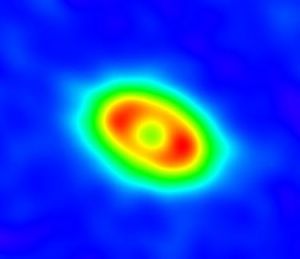 A star is typically born with a disk of gas and dust encircling it, from which planets develop as dust grains in the disk collide, stick together and grow. These disks, warmed by the star to a range of temperatures above the cold, ambient interstellar material, can be detected at infrared or millimeter wavelengths, and their infrared color used to characterize their properties. Stars older than about five million years lack evidence for these disks, however, suggesting that by this age most of the disk material has either been converted into planets or smaller bodies, accreted onto the star, or dispersed from the system. Transition disks bridge this period in disk evolution: They have not yet been disbursed, but although they are present they emit only slightly in the infrared. Their emission shows characteristically cooler temperatures, and signs that the innermost (hottest) regions have already disappeared and left a gap (or cavity) in the ring.
A star is typically born with a disk of gas and dust encircling it, from which planets develop as dust grains in the disk collide, stick together and grow. These disks, warmed by the star to a range of temperatures above the cold, ambient interstellar material, can be detected at infrared or millimeter wavelengths, and their infrared color used to characterize their properties. Stars older than about five million years lack evidence for these disks, however, suggesting that by this age most of the disk material has either been converted into planets or smaller bodies, accreted onto the star, or dispersed from the system. Transition disks bridge this period in disk evolution: They have not yet been disbursed, but although they are present they emit only slightly in the infrared. Their emission shows characteristically cooler temperatures, and signs that the innermost (hottest) regions have already disappeared and left a gap (or cavity) in the ring.
CfA astronomer Sean Andrews and his colleagues have been studying transition disks in nearby star-forming regions located in constellations of Taurus and Ophiuchus. The astronomers note that the gaps in transition disks they see might have been caused by one or more of three processes: grain growth and planet formation that depleted the material, a giant planet in the vicinity that swept the region clean, or a stellar wind that blew away or evaporated the dust.
See more at: CfA News
Read the pre-print on astro-ph

